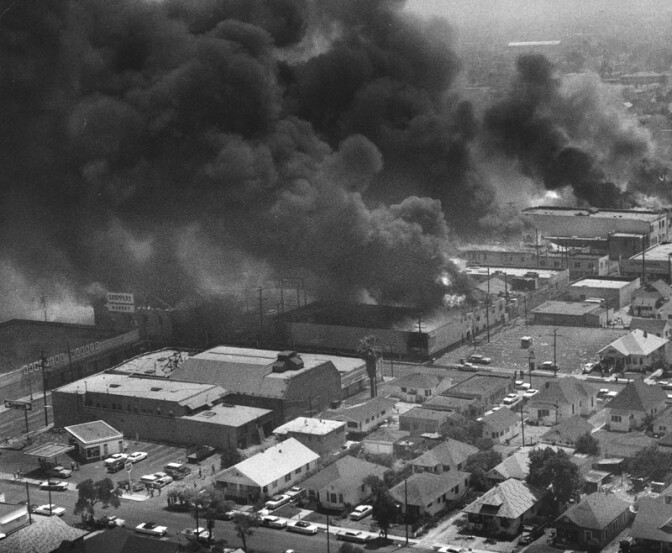1960s - South Central Los Angeles and Gentrification
.... "Few issues troubled African Americans in postwar Los Angeles more than the complete deterioration of their relationship with the Los Angeles Police Department." The reputation of the LAPD became especially notorious under the reign of Chief William Parker from 1950 to 1966. Parker is infamous for many reasons. He is credited with not only promoting racial profiling and aggressive policing but also with harassing businesses and patrons along Central Avenue so frequently that his policing methods led to not only breaking up Central Avenue's vibrancy but the 1965 Watts Riots.
One illustration of Parker's totalitarian tactics is cataloged by Mike Davis in "City of Quartz." "Under Parker — a puritanical crusader against 'race mixing' — nightclubs and juke joints were raided and shuttered," writes Davis. "In 1954 John Dolphin, owner of Los Angeles' premier R&B record store near the corner of Vernon and Central, organized a protest of 150 Black business people against an ongoing 'campaign of intimidation and terror' directed at interracial trade. According to Dolphin, Newton Division police had gone so far as to blockade his store, turning away all white customers and warning them that "it was too dangerous to hang around Black neighborhoods." It was episodes like this that culminated in the 1965 Watts Riots.
Another issue that stifled the spirit of the community was the California State Highway Commission's campaign to build both the 110 and I-10 through the heart of South Central Los Angeles. The path for Interstate 10 was especially troubling because it cut through a 500-foot-wide section of West Adams known as "Sugar Hill." "Sugar Hill" was considered one of the most beautifully well-kept neighborhoods of African Americans anywhere in America. Josh Sides explains further that, "Believing that the selection of this route was at best insensitive and at worst racially motivated, a group of West Adams residents immediately formed the Adams-Washington Committee, choosing several delegates to present the community's grievances to the commission in Sacramento."
Sides also notes that African Americans in Santa Monica opposed the proposed route through their area too because it bisected the small black community in Santa Monica, similarly in the enclave near Pico Boulevard around 26th Street. The great Los Angeles African American poet Kamau Daaood was born in this section of Santa Monica in 1950.
Ultimately, Interstate 10 was built through both neighborhoods destroying hundreds of houses. A similar process happened 10 miles east of Sugar Hill in Boyle Heights, where five freeways intersect, including the 10. This destructive process of freeway construction through neighborhoods of color not only occurred in Los Angeles but also Minnesota, the Bay Area, Maryland, Louisiana, Washington, Texas, New York and Massachusetts. Accounts of the devastation of freeway construction in neighborhoods of color across Los Angeles can be read in both Eric Avila's "The Folklore of the Freeway" and Helena Maria Viramontes' "Their Dogs Came With Them." Eric Avila's 2014 book spotlights the creative strategies urban communities across America used during the 1950s, '60s and '70s to document and protest the damage highway construction wielded on countless neighborhoods.
"The spate of racial violence that erupted in American cities in the mid-1960s," Avila declares, "shocked white Americans who had insulated themselves within exclusive suburban enclaves, willfully ignorant of inner-city conditions of racial poverty. After riots in the Los Angeles neighborhood of Watts, 1965 became America's 1848, sparking more stringent demands for racial equality and drawing the world's attention to America's latest race problem. In the depths of inner-city despair, highway construction added insult to injury, fanning the flames of racial unrest."
The 1965 Watts Riots and Civil Rights Movement
As Avila insinuates above, issues like highway construction combined with frustration with the LAPD, the brewing unrest of racial inequality and inner-city poverty contributed to the outbreak of six days of rioting in Watts in August 1965. The catalyst for the riots occurred on August 11 on a warm night when a highway patrol motorcycle officer pulled over a young African American man named Marquette Frye for speeding.
A large crowd assembled around the officers as they attempted to arrest Frye, and the unrest began. Further details on this episode have been written about in countless books, but as Martin Schiesl writes, the six days of rioting "covered about 46 square miles and left thirty-four persons, mostly black, dead; 1,032 wounded, and 3,952 arrested. Property damage amounted to $40 million, with over 600 buildings damaged and destroyed." Over the next few years, several similar riots occurred across America, like the 1967 Detroit Riots. These episodes further galvanized the emerging Civil Rights Movement and connected with the creative branch of the Black Power movement, the Black Arts Movement.

Buildings on Fire, Watts Riots | LAPL
Following the summer of 1965, Watts and South Central Los Angeles became a hotbed of the Civil Rights Movement. Organizations like the Studio Watts Workshop, the Watts Writers Workshop, the Watts Towers Arts Center, Pan Afrikan People’s Arkestra, the Black Panthers and US Organization utilized both the arts and direct action as methods to raise awareness and attempt to create social change. These groups and many others were highly active in the community well into the mid-1970s. The 1973 documentary film “Wattstax” captures the magic and optimism of this period. 103rd Street in Watts was one of the epicenters. During this period, the lively artistic and musical spirit that was originally on Central Avenue started moving west to streets like Normandie and Western and eventually to Crenshaw and Leimert Park.
From about 1965 to 1975, the Black Arts Movement in Los Angeles flourished in Southern California. It continued beyond 1975, but economic conditions and public policy in the late 1970s and the rise of Reagan in the 1980s led to less funding for the arts and more difficult circumstances for artists and musicians. Economic restructuring in the manufacturing sector and other changes in the economy made jobs scarce.